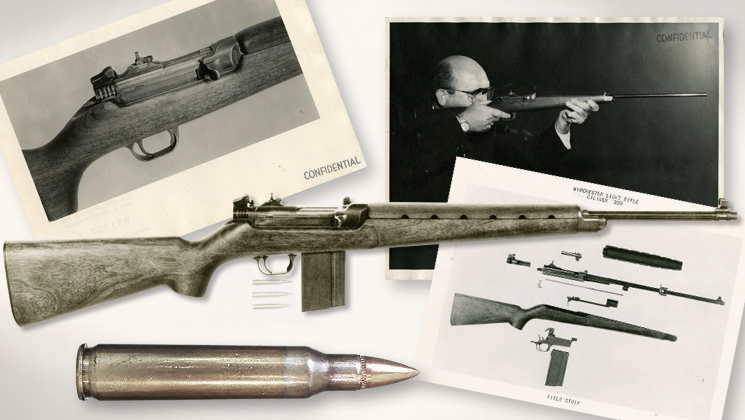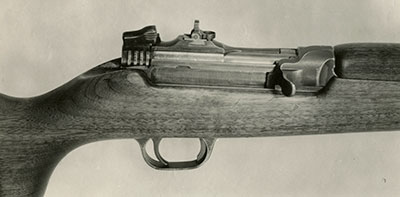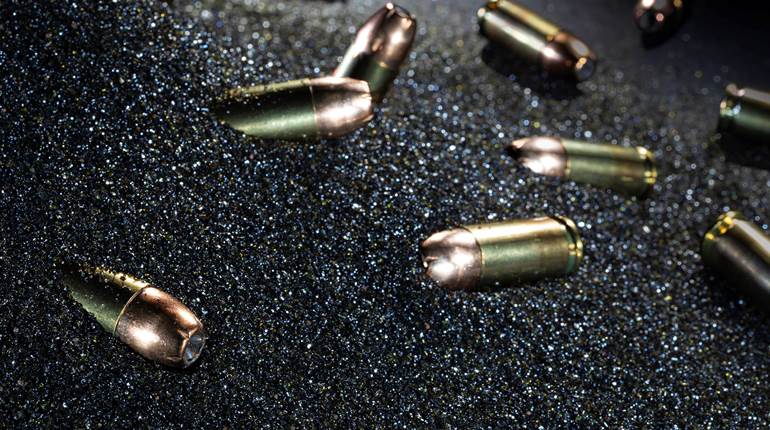

In 1948, the U.S. Army formed the Operations Research Office (ORO) to study and evaluate the effectiveness of infantry arms during the recently concluded Second World War. Foremost among the conclusions reached by the ORO was that most infantry engagements took place at 300 meters or less. It was determined that volume of fire was more important than aimed shots and that our military would be better served by infantry weapons with low recoil, firing smaller-caliber, higher-velocity projectiles. The standard M1 Garand semi-automatic rifle and its potent .30 Springfield (.30-’06 Sprg.) cartridge were deemed too heavy and unnecessarily powerful for the average infantry engagement. While the trim .30-cal. M1 carbine was a lightweight shoulder arm, its cartridge did not possess the range, velocity or lethality to make it an effective standard battlefield infantry arm. By the mid-1950s, it was proposed that the ideal rifle would be a selective-fire (capable of full- and semi-automatic fire) rifle weighing no more than 6 lbs. with a 20-round detachable-box magazine. The desired cartridge would be a high-velocity .22-cal. center-fire chambering capable of completely penetrating a military-style helmet at a range of 500 meters. The proposed cartridge was mandated to fire a 50-to-55-gr. bullet at a muzzle velocity of approximately 3,000 f.p.s.
Since there was not an infantry rifle in our small arms arsenal possessing the desired attributes for the proposed “infantry rifle of the future,” the U.S. Army Continental Command (CONARC) solicited proposals from several sources for such an arm. Two of the entities submitting proposals were the Armalite Division of the Fairchild Engine and Airplane Corp. and the Winchester-Western Division of Olin Mathieson Chemical Corp. Although they were faced with the same design parameters, the companies tackled the project from different directions.
While seemingly an unusual player in the arena of military firearm design, Fairchild sought to diversify from its main business of manufacturing aircraft. The firm had previously engaged the services of gun designer Eugene Stoner. Stoner and the Fairchild team subsequently developed several innovative firearm designs that made extensive use of aluminum alloys and plastic. Stoner had already designed the futuristic-looking AR-10 rifle chambered for a powerful 7.62x51 mm cartridge, and the company was working on refining that design. In order to meet the CONARC requirements, Armalite essentially scaled down the gun for use with the smaller .22-cal. cartridge as mandated by the Ordnance Dept. performance parameters for the proposed new rifle. The prototype rifle, designated as the AR-15, had a straight-line stock with separate pistol grip and fixed carrying handle on top of the receiver. The plastic/composite stock/fore-end design was strikingly unique for its day as compared to the familiar steel-and-wood service rifles.

The new AR-15 rifle was chambered for a cartridge based on the commercial .222 Rem., which was subsequently improved to increase its performance. The revised cartridge eventually became the .223 Rem. and fired a 55-gr. bullet at a muzzle velocity of 3265 f.p.s.
On the other hand, rather than develop a totally new arm, as was the course taken by Fairchild and Stoner, Winchester based its design for the proposed new rifle on guns the company had already developed during World War II. During the war, Winchester had engaged the services of a talented, but sometimes volatile, gun designer named David Marshall Williams. Williams had previously designed the short-stroke gas piston that was used on the famous M1 carbine. Winchester also utilized the same basic gas system design on several prototypes it developed during the war, including the G30 series of rifles that the company hoped might supplant the M1 Garand rifle and the Winchester Automatic Rifle (WAR) that was intended to take the place of the BAR (Browning Automatic Rifle) (Sept. 2015, p. 72). Only very limited numbers of the G30 or WAR were fabricated and tested, and none were adopted by the U.S. military. Nevertheless, both functioned reasonably well during the various World War II tests, so Winchester dusted off the blueprints for these guns in order to come up with an entrant to meet the new CONARC specifications. Since Williams was no longer actively employed by Winchester, the new “Light Rifle” project was headed by Ralph E. Clarkson, a member of the company’s design and engineering team. The company designated the new gun the “Winchester Light Weight Military Rifle” (WLWMR).

The design philosophy for it was described by Winchester in a 1958 manual: “From the very beginning of the development work on the Winchester Light Rifle it was considered of utmost importance that reliability must not be sacrificed to obtain low weight. As a consequence, a policy decision was taken that the new Lightweight Rifle was to be designed on the basis of well-proven earlier guns whose field reliability had been established through extensive testing. As a result, the best elements were taken from the Winchester .30 Caliber Experimental Light Rifle, the G30R Semi-automatic Rifle, the WAR Automatic Rifle and the .50 Caliber Semi-automatic Anti Tank rifle, to serve as a basis for development of the Winchester Lightweight Rifle.
“By basing the development of the new rifle on proven elements, the extensive testing experience gained with the earlier rifles was utilized for the new Lightweight Rifle, yielding a weapon design of good inherent reliability and short development time to production status.

“During the extensive development of the weapon a great number of significant changes were incorporated, resulting in improved function and facilitated production. A key feature of the rifle is that all sub-assemblies are functionally self-contained. Since none of the sub-assemblies rely on adjacent components for primary function, difficulties due to tolerance accumulations are eliminated.
“To assure reliability under field conditions it was decided from the start that only steel was to be used for primary action parts [bold print added by author]. Consequently, barrel, receiver and all parts subject to dynamic loading are manufactured from steel to obtain high strength and wear resistance. Aluminum 7075-T6 is used only in components where no dynamic forces or impact occur. A typical example of such a part is the trigger guard which has to withstand only static forces. The stock of the Lightweight Rifle is American walnut.
“Low weight is thus achieved by sound design using conventional materials without compromise of gun life.”
An Ordnance Dept. comparison of the two contenders showed that the Armalite design contained 113 parts while the Winchester gun had only 70 parts, which was obviously an advantage for the latter gun. It is worthy of note that Winchester took pains to point out that its design was made using steel for the primary action components rather than the aluminum alloy metal utilized by Armalite. This feature was undoubtedly emphasized, at least in part, because there were some, in and out of the Ordnance Dept., who were wary regarding the durability of non-ferrous alloys and plastics used by Armalite as compared to the tried-and-proven steel-and-walnut construction of the Winchester rifle. These concerns were echoed in some Ordnance reports that the conventional steel and wood used by Winchester would be less costly and more available in “an emergency” than the lightweight alloys and plastics used by Armalite.

In order to fulfill the requisite design parameters mandated by CONARC, Winchester developed a high-velocity cartridge, designated as the “.224.” This was followed shortly by the improved “.224E1,” which fired a 53-gr. bullet at a muzzle velocity of 3300 f.p.s. While the cartridge wasn’t identical to the Armalite .223 cartridge, its performance was deemed similar enough for the two rifles to be tested side-by-side.
The Mathewson Tool Co. aided Winchester in the project, and a working WLWMR prototype was completed in the fall of 1957. According to recently discovered Winchester archival photos, at least three different patterns of the lightweight rifle were fabricated—one in military configuration and at least two models with differing barrel lengths and sporter-type stocks.

The prototype .224 Winchester rifle was demonstrated at Fort Monroe, Va., on Oct. 25, 1957, and at Fort Benning, Ga., on Nov. 6, 1957, along with the Armalite prototype AR-15 .223-cal. rifle. The results of those demonstrations were sufficiently impressive for CONARC to order 15 WLWMR rifles from Winchester along with a similar number of AR-15s from Armalite. Each company was directed to send 10 of its rifles, along with 70,000 rounds of respective ammunition, to Fort Benning for more extensive testing. Also, each contractor sent two rifles and 20,000 rounds of ammunition to Aberdeen Proving Ground along with one rifle and 5,000 rounds to both Frankford Arsenal and Springfield Armory. The tests on the Armalite and Winchester rifles were concurrently conducted at Aberdeen and the Army’s Infantry Board.
It is reported that the Infantry Board concluded that the Winchester .224 rifle’s performance was comparable to that of the newly adopted M14 7.62 mm rifle with the exception of the smaller-caliber bullet’s inability to penetrate heavy brush and foliage. One problem that occurred during testing was an inconsistent ejection pattern, which was attributable to a glitch in the design that was easily addressed. Army Chief of Staff Gen. Maxwell D. Taylor fired the Winchester .224 rifle and was reportedly impressed with its handling characteristics. The subsequent test report of the WLWMR included the following:
“Conclusions:
“The Lightweight Military rifle has the advantage of light weight, light recoil, favorable handling qualities, and convenient disassembly and assembly, but it has poor accuracy, function and endurance characteristics.
“Recommendations:
“The mechanism be redesigned to improve function and endurance. The automatic fire feature be eliminated (this was also recommended for the AR-15).
The barrel be redesigned to give a higher level of safety when fired under adverse conditions and improved accuracy.
“The rear sight be replaced with one which permits elevation and windage adjustments.”

Since the .224E1 cartridge did not meet the Army’s penetration requirements, Winchester lengthened the cartridge case slightly in order to increase the powder capacity. The revised cartridge was designated as the “.224E2.” There was also a small experimental quantity of steel-bulleted .224E2 cartridges fabricated. Even with these changes, subsequent testing revealed that the .223 cartridge used with the Armalite rifle performed better than the .224-cal. Winchester cartridge, especially regarding penetration at longer ranges and durability of the ammunition under adverse conditions.
When the 1958 test results were finalized, Winchester had a tough decision to make regarding continued development of the .224 WLWMR, as there were a number of factors to consider. Winchester would have to bear all subsequent development costs, and there were serious doubts within the company whether or not any government orders would be forthcoming. Also, the possibility of a civilian version of the gun was discussed, but it was not believed that sales would be sufficient to pay for the continued development cost. Also, as pointed out by arms historian Konrad F. Schreier, Jr.:
“Another consideration was that many, if not most, of the U.S. Army people who were, or would be, associated with the new rifle were not the old school of fully trained, experienced ordnance engineers. Many of them were not even engineers, or trained ordnance officers, but officers from the combat arms. This was of great concern to Winchester.
“A further concern was that the Armalite rifle was, at the time, backed by the Fairchild Engine & Airplane Corp., and they were prepared to go to any lengths to promote their rifle without consideration of the cost.
“Winchester then found that the new generation of U.S. Army people were mostly the type that became enthralled with what old timers and ordnance people called ‘the Buck Rogers Armalite rifle.’ These people believed that the Armalite, despite its complex and unorthodox design, would prove superior to any military rifle yet developed. Winchester, a builder of conventional arms, believed competing [against] people who thought that way would not be productive.”
Given these considerations and other issues, Winchester decided against further development of its .224-cal. Light Weight Military Rifle. With the decision made to bow out of the Light Weight Rifle competition, Winchester accepted a contract to manufacture the newly adopted M14 rifle and subsequently produced 356,501 of them between 1959 and 1964.
Even though the government did not adopt a “Light Rifle” in the late 1950s, the Armalite rifle had captured the interest of a number of influential officers in the U.S. Army. As events transpired, the Armalite design was eventually adopted in 1964 as the M16 .223 caliber (5.56 mm) rifle. Despite some initial “teething problems” experienced with the M16 soon after its widespread issue and use in Vietnam, the rifle and cartridge were modified to improve the performance and they eventually proved to be a satisfactory combination. Amazingly, the basic design remains the standard American military service rifle today, almost six decades after it was first tested against the WLWMR.
One wonders what the current American military rifle would look like today if Winchester had decided to pursue continued development of its .224 caliber Lightweight Military Rifle. It is probable that the M16 would still have been adopted, and Winchester would have wound up with a costly prototype on its hands that was of no interest to either the military or the commercial markets. Like the old adage goes, sometimes you have to “know when to hold ’em and know when to fold ’em.”





































